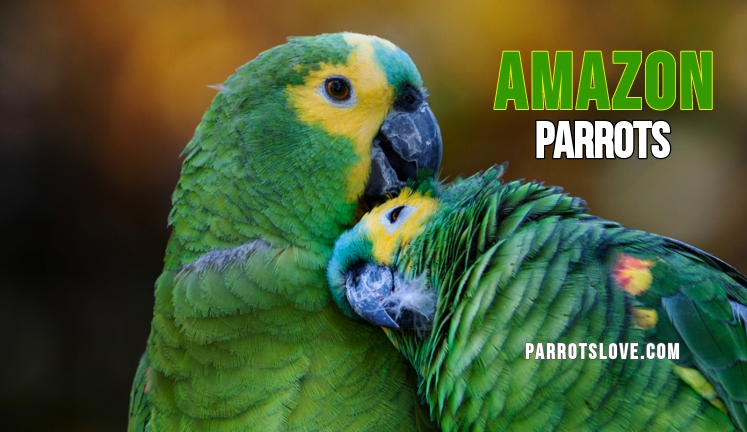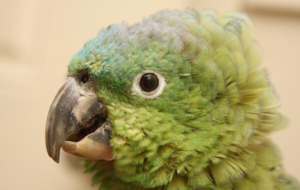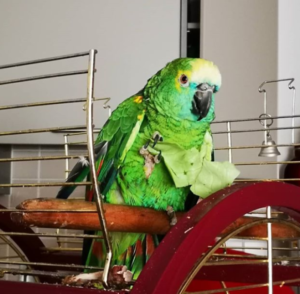
Amazon parrot is a common name for a parrot from the Amazona genus. These medium-sized parrots are native to the New World, including South America, Mexico, and the Caribbean. Most amazon parrots are mostly green, with bright accent colors that vary by species.
Amazon parrots are very intelligent birds that are frequently described as noisy, energetic, and extroverted; some even like singing. Male Amazons are known for their “macho” behavior, which includes flaring their tail feathers, pinning their eyes, and “strutting” over the floor or tabletop.
Most Amazon parrots enjoy bathing, which might include accompanying their owner in the shower, taking a spray bath, or jumping into their water dish and splashing water all over. Bathing is an essential aspect of an Amazon’s feather health. Because of their love of eating and habit of begging for table meals from their owners, Amazon parrots are prone to obesity. An Amazon parrot requires a large cage with toys and swings spread out, as well as a play gym/play tree, climbing rope, and/or ladders to stimulate mobility and exercise.
The best food for Amazon parrots
Amazon Parrots Diet:
- Amazon Parrots should be fed a high-quality, appropriately proportioned parrot/bird mix supplemented with various fruits, green foods, millet spray, and, on occasion, mealworms.
- A parrot’s daily diet should include vegetables, fruits, and greens.
- An Amazon parrot has a voracious appetite, particularly for human food, therefore owners must ensure that they (and other household members) do not overdo it on snacks and table meals.
- An Amazon parrot’s main food should include a nutritionally balanced manufactured diet as well as a variety of healthy vegetables, fruit, and healthy treats that provide nutrition rather than empty calories.
- Amazon parrots enjoy the texture of food as much as the taste. However, they are prone to obesity, therefore owners should monitor their daily food intake and variety.
Amazon Parrot Care
- Enclosures should be as large as feasible, so that the bird may fully stretch and flap its wings without contacting the cage walls.
- Cages should be clean, secure, safe, and made of sturdy, non-toxic materials.
- Perches should be of various widths, heights, and textures. Also, give a concrete perch to help with toenail maintenance.
- Avoid placing perches directly over food or water to prevent infection.
- Access to natural light is preferable.
- Avoid drafty places.
- Parrots should be kept in their cage or a “bird-safe” room when not under direct observation.
- Birds with unfettered access to the home are vulnerable to accidents such as poison ingestion, electrocution, pet attacks, and drowning.
Other diseases/conditions that affect Amazon parrots include polyomavirus (may cause anorexia, lethargy, weight loss, and mortality), chlamydiosis (symptoms include decreased appetite, fluffed feathers, and nasal discharge), and vitamin-A insufficiency if fed an inadequate diet.
Interesting Facts and Quirks:
Amazon parrots emit a peculiar odor originating from their respiratory system. This stench is not unpleasant, and those who enjoy Amazon parrots frequently link it with something positive. The odor is more evident near the nares. The purpose of this odor is unknown at this time, as most birds have few scent receptors.
Potential Behavior Problems:
Amazon parrots have a reputation for becoming aggressive once sexually mature, hence some breeders refuse to breed them for the pet trade. Several Amazon species have been designated as “hot” by behavior consultants, indicating that they will likely exhibit aggressive behavior as they age. Unfortunately, this designation is more frequently the result of a lack of knowledge about how to train Amazon parrots using positive reinforcement. There are many examples of mature, well-behaved Amazon parrots.
Amazon Parrot Lifespan
The thing about parrots is that they live so long. That’s good news for them, of course, when they’re out in the wild. But bad news when they’ve been domesticated and need to find a forever family … for 80 years.
How Much Is An Amazon Parrot
Amazon parrot for sale: Amazon parrot Price: $400 to $1,000 for most species, although very rare Amazons can go much higher. As always, try to buy a weaned bird from a breeder that handles their babies a lot.

Is an Amazon parrot a good pet
Are Amazon Parrots Aggressive
Amazon Parrots Smell
Which Amazon parrot is the best
Top Pet Amazon Parrot
- Lilac-crowned or Finsch’s Amazon (Amazona finschi)
- Orange-winged Amazon (A. amazonica)
- Blue-fronted Amazon (A. aestiva)
- Mealy Amazon (A. farinosa)
- Yellow-crowned or yellow-fronted Amazon (A. ochrocephala)
- Double yellow-headed Amazon (A. o. oratix)
Yellow-naped Amazon parrots, double yellow-headed Amazon parrots, blue-fronted Amazon parrots, orange-winged Amazon parrots, lilac crowned Amazon parrots, Mexican red-headed Amazon parrots, white-fronted Amazon parrots, and mealy Amazons are all popular pet parrot species.


Leave a Reply